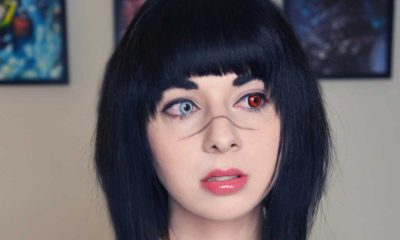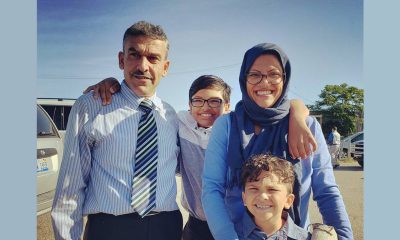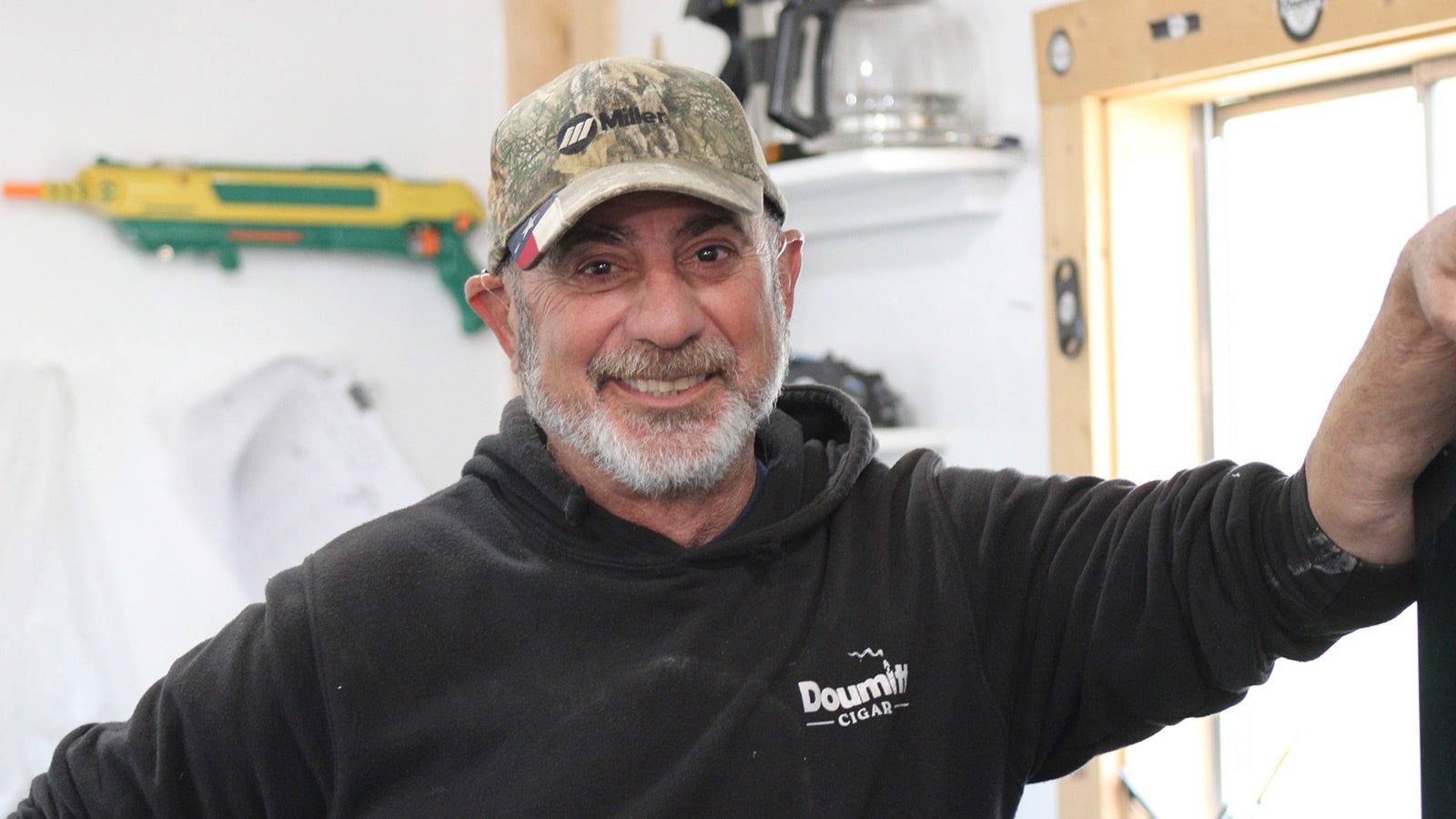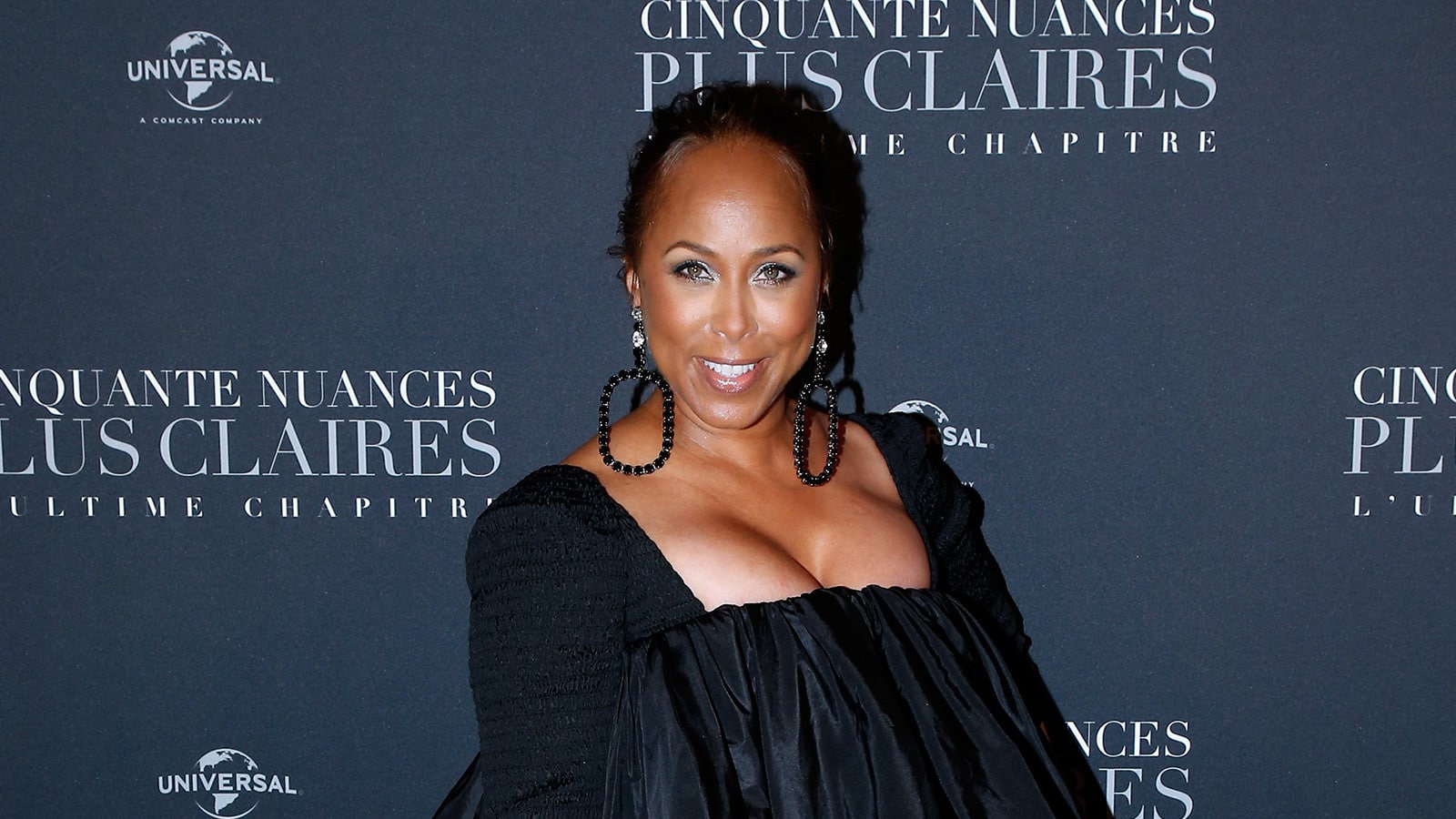Lists
What are conjoined twins Krista and Tatiana Hogan doing now?

Krista and Tatiana Hogan, conjoined twins from British Columbia, Canada, gained much more prominence after the CBC documentary, “Inseparable: Ten Years Joined At The Head,” covered their story in 2017. The cameras captured a year in their life around their 10th birthday and how their family, at the time consisting of parents, grandparents, three siblings, and a dog named Yuna, helped them live a fulfilling life. Here’s what makes the twins distinctive, and how they handled the media spotlight.
Contents
Tatiana and Krista are unique
The conjoined twins, or Siamese twins, are joined in utero, and the phenomenon is still not fully explained. The Canadian girls were a rarity through birth alone; about half of the twins with this birth disorder are stillborn, and roughly a third of those who survive die within 24 hours. Moreover, Tatiana and Crista are craniopagus twins, meaning that they are joined at the head, which only happens to one of 2.5 million twins. However, their brain structure makes them the only such twins in Canada and perhaps the world. They can do things that still confuse neurologists, including reading each other’s thoughts, seeing out of each other’s eyes, and sharing some senses. However, they’ve had several medical issues and underwent physical therapy in the show. Besides a reduced quality of life, they will likely have a shorter lifespan.
Other networks covered their story before CBC
Most people don’t realize that Tatiana and Krista agreed to share their unique experience with the world long before the CBC documentary. They were featured in the Vancouver Sun segment in 2013, and The New York Sun interviewed them a year earlier. ABC media network was one of the first media networks to bring light to their unique lifestyle and medical mystery in June 2010.
All investigations agree on one thing; the sisters have different personalities and are full of life seemingly despite unsurmountable odds of surviving childhood and living a normal life.
Besides different characters, they had distinct body weights from birth on 25 October 2006. Krista was always a bit bigger, quieter, quirkier, and loved telling jokes, while Tatiana was hyperactive, chatty, loud and outgoing. Kristi’s funny side came out at the documentary’s beginning since she jokingly said that she doesn’t like being stuck to her sister because ‘she’s annoying.’ In contrast, their mom called Tatiana ‘a little bully.’ She spoke from experience; the girls have three siblings, a younger sister Shaylee, an older sister Rosa, and an older brother Cristopher “Toad” Hogan.
They are a medical miracle
Doctors who conducted a CT scan of their heads when they were a year and a half old have concluded that they could never separate them because of how their heads are fused. They learned that the girls didn’t have two joined skulls; instead, they had one skull or cranium with four brain hemispheres inside. With that information in mind, trying a separation operation would put them at risk of infection, severe injury, and quite possibly death.
However, the scan also showed that the twins’ connection is unique; they have a bridge that connects their thalami, a gray matter shaped like an egg that controls sensory input and the brain’s motor functions. Because theirs are linked, the sensory input and blood go back and forth, like they are using a switchboard. Therefore, the twins share the senses of taste and touch, and Krista can see out of one of Tatiana’s eyes while Tatiana can see out of both of Krista’s.
Moreover, they can control each other’s limbs besides self-control; Krista can move three legs and an arm, while Tatiana can control a leg and three arms. Finally, they learned that Tatiana’s heart was working harder and supplying some of its blood to Krista’s brain, which made Krista’s blood pressure higher. Doctors plan to solve this by jumpstarting Krista’s heart to adjust its rhythm, and make it pick up the pace. Yet, their most amazing ability, at least to outsiders, is knowing each other’s thoughts without speaking, which they call ‘talking in their heads.’
Krista and Tatiana don’t let the medical issues stop them
Although it’s uncertain if being conjoined had an effect, the twins have epilepsy and type 1 diabetes. They are on a strict medication regimen, most undergo blood tests to manage their sugar, and require daily insulin injections, and thus often travel to the British Columbia Children’s Hospital in Vancouver. That was a hit for their finances because the girls live in Vernon, British Columbia, with mom Felicia Simms, dad Brendan Hogan, grandparents Louise ad Doug McKay, and some aunts and uncles.
Despite all the physical problems, the twins travel to school, ride a customized bicycle, and swim. During winter, the twins go down hills on toboggans, and have tried cross-country skiing.
They are pursuing education
Krista and Tatiana had a slightly delayed education path due to their unique situation. They delayed starting kindergarten at Okanagan Landing Elementary to fly to Manhattan and appear on Anderson Cooper’s daytime talk show, “Anderson.” Their mother said that most children around their age were curious, and some befriended them. However, a few parents were uncomfortable seeing them, and forbade their children to play with them, which Felicia openly criticized, prompting her to ensure that her children never shun anyone for being different.
Although their unique congenital disorder slowed their academic progress, the documentary showed that they started attending regular school. The twins spent a few hours per day in Grade 6 as of September 2017, learning to write, read, and do basic arithmetic.
Twins live their lives away from the public
Sadly, the CBC documentary was the last public update from the twins, and that was seemingly intentional. Chuck Harris, a Hollywood agent, is the only reason they became well-known for several years. He signed the twins for all the media appearances in the late 2000s and early 2010s because he ‘wanted to get a reality show for them so badly, to make big money. For them, anything over $1,000 is big money.’
He explained that the family had fourteen members in one household in 2011. Their mom, known for being protective, agreed to Chuck’s proposal, and told him, ‘We can do interviews and documentaries. Just get the word out. I want people to understand that’s just what they are—they’re just little girls.’
LIVE: Born conjoined at the head 10 years ago, meet Krista and Tatiana Hogan in a new documentary from @JudithPyke .https://t.co/v5H4AHmyop pic.twitter.com/bHtVNSZYNB
— CBC British Columbia (@cbcnewsbc) November 4, 2017
Chuck also represented George and Lori Schappel, the oldest living conjoined twins in the world as of 2022, according to the Guinness World Records notes. He also wanted to find their mom a job, giving parenting lectures and speculated that she could earn CAD$5,000 to $15,000 an hour, talking about ‘how she’s raising the girls, not hiding them, and doesn’t see their condition as a handicap.’
Krista and Tatiana contributed to science
Viewers saw the conjoined twins’ daily life, including all their struggles, which was captivating. However, their media appearances had a real impact on science and medicine. Their mother always knew that her daughters might not reach the average lifespan; the doctors told her that they had a 20% chance of survival at birth and that the danger was not over in the first 24 hours. Upon turning 10 in the documentary, their mother explained, ‘For them to actually be here for 10 years is just a blessing. It just felt so good to see them get to this milestone.’
However, the documentary also showed how amazed their pediatric neurologist, Dr. Juliette Hukin was, and how much she learned from their unique brainstem connection. Neurosurgeons and other medical professionals they met had a similar reaction.
Ultimately, their mother never wanted fame or preferential treatment for them. At the end of the episode, she said, ‘They’re just little people living their lives like the rest of us. That’s how we see them, and that’s how their siblings see them.’
Moreover, Tatiana and Krista have inspired clinical research. Their case has been cited in many clinical studies, for example, “Craniopagus: Overview and the Implications of Sharing a Brain” by Jordan Squair at the University of British Columbia’s Undergraduate Journal of Psychology in 2012.
Lists
What happened to Juliana Custodio after divorcing Michael?

Juliana Custodio finally got her big break from the poverty of her home country by finding a way to marry into wealth in late 2019, at which point she was also featured in TLC’s hit reality TV series entitled “90 Day Fiancé.” Looking at the vast difference in pretty much every aspect of what makes a human being between her and Michael Jessen, the supposed love of her life, claims that her feelings for him are genuine can be seen as no better than suspiciously dubious.
Lo and behold, their marriage didn’t even last two full years before Juliana broke it up, and went off to marry a younger man whose lifestyle coincided much more closely with her own. Juliana’s course of action is seen by many as the gold digger guidebook, since very few among the audience ever believed that she actually loved Michael.
With that also came the interest in how she fared after the marriage and away from the spotlight, as her future partners are very likely to have seen the series or at least heard of it, meaning they’d be well aware of Juliana’s true intentions, and thus less likely to fall prey to her supposed charm.
So, the question really is, did the world become harder for Custodio to live in following her split from the only man who truly trusted her? In order to glimpse the real answer, it’s necessary to encompass numerous facts about Juliana’s character that have come out over the course of her presence in the show.
Contents
A life-changing fiesta
Juliana grew up in a not-so-prominent neighbourhood of Goiânia, which is the capital of the Brazilian state of Goiás. Living in a country whose four percent of GDP is only spent on remedying road accidents that cause approximately 23 deaths across 100,000 people per year is most likely not a very positive experience.
This is aside from the fact that she was born there in 1996, meaning that the drug wars of the ‘90s were also in full swing at a time when her parents were trying to raise a baby. Criminal success brought about fascination with crime among the younger generations, which consequently led to a much lower interest in academic pursuits.
As a result of numerous negative factors, Brazil remains a destabilized crime capital even in mid-2023, with femicide and gang violence still being some of the worst issues that the country’s civilians have to deal with on a daily basis. Juliana, like many other young Brazilian women, was understandably sick of that life, and determined to seek her fortune elsewhere.
It’s small wonder, then, that Brazil is known for its prevalence of plastic surgery among younger individuals, with aesthetic medical procedures being the main gift of a young teenager’s parents for their 16th birthday, instead of a vehicle as often in the US. Juliana and many other Brazilian youths attempt to use this beauty to find a future elsewhere, doing everything they can to raise their chances.
Such was the case with Custodio as well, who frequented fun events as far away abroad as possible, usually in the company of someone wealthy enough to afford her the pleasure, most commonly found on dating apps such as Tinder, Hinge and Bumble.
Juliana couldn’t have imagined the opportunity that waited for her during a regular party trip to Croatia, coming across the man who would pretty much gift her permanent rights to stay in the US. Michael himself was probably overjoyed at still being able to seduce a young and healthy woman, considering that his age at the time (42) was almost double that of Juliana (23).
As for the young Brazilian, her eyes glimmered at the sight of a wealthy businessman who has no current wife, and all the time in the world to give to the right woman – there was nothing more she could’ve asked for. This instantly made him the most attractive man on the planet to Custodio, and she had to do something about that.
The details of their first encounter are scarce, but fans have theorized that she may have given Michael a night so memorable that he couldn’t take his mind off her all throughout the following months. Ultimately, the middle-aged businessman and the wannabe rich wife both had exactly what they were looking for, so it was time for the next logical step.
Overcoming distance
After supposedly falling in love, and returning to their respective homes from wild nights in Croatia, Juliana and Michael only had one problem in their relationship. To be exact, they had 4280 problems, or miles (6888kms), standing between Greenwich, Connecticut USA, and Goiânia, Brazil.
Online messaging just wasn’t enough, and they were both sure of what needed to happen next. Juliana was determined to somehow incorporate herself into the idyllic life of her new beau, applying for a tourist visa at the US embassy. This decision turned out to be more than either of them had bargained for, prompting them to seek a different solution altogether.
The application process for a US tourist visa is deemed quick and easy for Brazilian citizens, in the event that all the necessary documents and information are accurately provided. Applicants are required to fill out the DS-160 form, obtain a Labor Condition Application (LCA) from the US Department of Labor, and attend a visa interview. These steps ensure that applying individuals meet the criteria and requirements set forth by US legislative bodies.
On top of that, the wait times before the process is simply put into motion can be quite lengthy, depending on the applicant queue, the political situation, economic fluctuations, and various other factors. If no additional wait time is incurred by the aforementioned, there’s also the limitation of workload and staffing at the embassy or consulate which the applicant has contacted.
The tourist visa was ultimately too difficult for Juliana to obtain, although details about the endeavour have never been clarified. She perhaps didn’t pass the interview, didn’t have all the appropriate documentation, or simply was simply impatient, and thus cancelled it altogether. Whatever may have happened, she made sure to inform Michael that there would have to be another way for her to earn the right to visit the US.
Miraculously, Jessen then thought of what is undoubtedly the most beneficial possible deal for Custodio, at his own subsequent expense. There are no limitations for the type of person a US citizen can become engaged to, after which their fiancé is practically gifted the K-1 visa, obtaining the right to stay in the country for 90 days under the condition of marrying the applying citizen within that period, or returning to their home country.
Michael probably gave this a thought or two, somehow ultimately arriving at the conclusion that Juliana feels the same way about him, in spite of the fact that he’s old enough to be her father. He then displayed the ultimate sign of trust and actually went through the simple procedure of providing the paperwork and funds to obtaining his wife-to-be’s K-1 visa.
This is also when her life would reach even greater heights, as the producers of TLC’s “90 Day Fiancé” caught wind of Jessen’s bold decision, inviting them to front the cameras so that the whole world can witness what was undoubtedly going to happen in the long run, as soon as Custodio got exactly what she needed out of the transactional union.
#90DayFiance Michael Jessen's house goes into foreclosure and his wife Juliana addresses break up rumors while traveling around Europe. https://t.co/4iBj1beZ2d pic.twitter.com/rE2qmnH3cj
— Starcasm (@starcasm) September 26, 2021
Nearly giving up on love
In the video uploaded by TLC Southeast Asia, entitled “90 Day Fiance Season 7: Michael and Juliana,” the businessman reveals crucial details about their struggles early on. The process of waiting for the K-1 visa was apparently so lengthy that the two almost completely scrapped the US plan, at which point Michael was to fully relocate his life to Brazil.
However, as it would later turn out, Juliana never really wanted to stay in her home country, so this course of action was out of the question. As fans pointed out over the years, in order for her to want to stay in Brazil with Michael, she would’ve had to actually love him. So, instead, the two waited as long as it took for the visa to be approved, eventually landing Custodio on US soil, where she now plans to remain for the rest of her life.
She was extremely lucky for that to happen as well, since there was almost nothing stopping Michael from moving over. He’s a self-proclaimed wine entrepreneur, and while the details of how he actually earns money have remained shady, it’s generally believed that he derives an excellent income from being the middleman in various lucrative wine deals.
Being in that line of work, Michael isn’t really obligated to a persistent physical presence at a specific location, and he could simply fly in from Brazil to land the deals that fuelled his teenage boyish dream of a life. However, he did mention having two big commitments back in the US, which would be his son Max and daughter Cece, from his marriage with Sarah Jessen.
Although the two were divorced, they remained in constant contact and on relatively amicable terms, having decided to do what’s best for their children instead. Besides, they’d been married for over a decade, and had had virtually no major fights. The main reason for their separation was Michael needing to fully live out of his suitcase at times, and not feel guilty for fully sampling all of the exotic delicacies at any given party.
Trouble in paradise
Much like her husband, Juliana also had a voracious appetite for the finer things in life, but unlike Michael, she wasn’t a prominent wine entrepreneur. This meant that the funds for her lavish choices had to come from Jessen’s pocket instead, which wasn’t agreed upon prior to every single purchase she made.
There were, indeed, times when Custodio would behave like a classic rich wife and just buy things on a whim, with money that she couldn’t even conceive earning. She didn’t have to, however, since Michael was such a loving almost-father to her. Still, there were limits to what she could get without turning her husband’s head, and a new expensive car was exactly that.
TLC UK’s video “Michael Finds Out His Fiancé Bought Herself A Car Using His Money | 90 Day Fiancé” showed exactly what had happened at the time, putting emphasis on just how brash Juliana had become since her marital arrangement had afforded her a life of peak comfort and luxury.
In spite of what is logical to believe, Custodio started living as if she was his wife even before arriving to the US. The purchase of a car whose specifics have never been released happened while she was still in Brazil and waiting on the K-1 visa to be processed. Michael had unfortunately given her his credit card before she even moved in – another sign of good will on his part.
She abused this trust, however, and he has since then been a lot more careful about giving her unsupervised access to his money. In the words of Jessen himself, ‘Why the f**k would you buy an automobile within weeks of when you’re coming to America?’ Juliana’s somewhat dubious explanation is that she was unsure whether the K-1 visa would work out, and thus wanted at least something solid to rely on if she were to stay in Brazil.
Of course, she didn’t bring the car along with her, probably planning for the hubby to buy her another one. Different continent – different vehicle, or at least that made sense in her mind at the time. Jessen wasn’t extremely naïve, however, and her spending sprees became a lot more controlled after she had arrived.
It’s no mystery that these terms of arrangement were nowhere near satisfactory for the luxury-hungry Brazilian, who was never able to afford even a shred of Michael’s living comfort. As a result, she found it appropriate to proclaim their marriage a doomed affair during the COVID-19 lockdown in October 2021.
A brand-new wallet
It didn’t take long for Juliana to capitalize on the fame that the series afforded her, and exploit her beauty for various fashion magazines, becoming a model in prominent agencies across several countries, including the UK, Brazil, Denmark and Italy as well as the US. Her newfound popularity also made finding another rich husband a simple task, and thus she eventually landed herself a younger Michael.
https://www.instagram.com/p/CpIgmYarJF8/
German art collector Ben Obscura soon became Juliana’s fiancé, and they weren’t tardy with family expansion either, as she gave birth to Benjamin James Louis Custodio on 19 July 2022. As of mid-2023, she continues to pose for numerous photoshoots all around the world, citing 85 countries on her Instagram page.
While many fans believe that Juliana has Michael’s naiveté to thank for all of her subsequent success, it remains clear that she did rather well for herself in the long run, as the life she always sought to have is now prominently displayed all over her social media.
Lists
How rich are the ‘Port Protection: Alaska’ cast? How much do they earn per episode?

About “Port Protection: Alaska”
The popular National Geographic series premiered in July 2015, and followsg the lives of the locals of the far-flung Alaskan community, who get by without law enforcement or government assistance, the show taking a fascinating look at how the hardy residents of Port Protection fend for themselves, and defy the odds in the face of what many consider permanent adversity.
Main cast members include Mary Miller, Stuart Andrews, David Squibb, Gary Muehlberger, Hans and Timbi Porter, Litzi Botello, Timothy Leach, and Amanda Makar. Gary, one of the stars of the show, tragically died in March 2021 after living in Alaska for almost four decades. An asset to the community thanks to his fishing and trapping skills, his death rocked Port Protection, and came as a blow to fans of the series. The survival expert died in a house fire; his pet dog, Trapper, also passed a few months later.
Mere months after Gary’s untimely demise, Litzi Botello’s husband John Dean, announced that the TV star had passed away after a six-month battle with cancer. Although he failed to clarify whether Litzi was undergoing chemotherapy at the time of her passing, John shared that she passed away peacefully at home.
Last but not least, Sam Carlson, the commercial fisherman and trapper who has lived in Port Protection all his life, suffered a heart attack in December 2022, which led to an outpouring of support from his online fanbase. The news broke in the official Port Protection Facebook group, and sparked health concerns regarding Sam, who is in his early 60s. Thankfully, the TV personality has since recovered.
Net Worths
A common question amongst “Port Protection” fans – and those of other reality TV series – is just how much their favorite TV stars earn per episode. Various online sources claim that the cast members earn $4,500 per episode, but there’s no substantial evidence to prove the figures; in fact many participants in reality TV series prefer to remain silent, except those who believe that they’re being underpaid! Assuming that they do earn that much, the members of the Alaskan community must have amassed a decent sum of money over the last eight years, although none of them live above their means or spend frivolously.
Port Protection itself has a tiny population of just 36 full-time residents as of 2023. With a total area of just four square miles, the CDP (census-designated place) is truly tiny but has become something of a niche tourist hotspot. With a normal median household income of around $10,000, over half of Port Protection’s population is living below the notional poverty line; however, wealth is relative in a place where residents grow their own crops, hunt and fish for their own food, and build their own shelter.
The stars of the National Geographic show are believed to be worth about six figures: in fact, one article sensationally states that Sam Carlson is worth $500,000, however, there’s good reason to believe that this is an exaggerated amount. The self-taught inventor, affectionally nicknamed The Engineer, has appeared in 38 episodes of the show since 2022; even if he were to have earned the reported $4,500 per episode, that would amount to $171,000, so we think that Sam Carlson’s net worth is actually in the $100,000 range.
It’s important to note that, unlike other reality TV personalities, the cast of “Port Protection” aren’t interested in becoming a brand or a product. For example, Fellow Port Protection resident Curly Leach doesn’t even believe in money, which makes it almost impossible to calculate his net worth. In the Alaskan community, his main responsibilities are fishing and collecting firewood; rather than paying or being paid for goods or services, Curly trades what he has to get everything he needs.
Despite being a recognizable face to millions of viewers, Curly is such an elusive ‘public’ figure that fans don’t even know how old he is. The only information journalists have been able to obtain is that the hardy outdoorsman registered as a Republican voter in 1996. As a hunter and lumberjack, we can assume that Curly is worth about $50,000; however, it remains unclear what he does with the money he earns from appearing in “Port Protection”.
#PortProtection’s Amanda Makar is an inspiration to us all. pic.twitter.com/zGZkx4OuwJ
— Girls Library ღ (@GirlsLibrary) May 24, 2016
Amanda Makar left the show at the end of season two, with fans missing her presence ever since. A spokesperson for National Geographic stated that many residents moved away from Alaska when the show was halted; however, they were just as soon replaced by fresh faces who were eager to try their luck in the tiny community. Amanda is just one of several cast members who left, and hasn’t been mentioned since.
In happier times, Timbi and Hans Porter were one of the few married couples to reside in Port Protection. During their time in the show, Timbi and Hans were often seen worrying about how to provide for their daughter, Marjorie, who was born with a disability. A few salacious online sources claim that the couple died in a boat accident; however, the truth is that they separated in 2019, and have since gone their separate ways, with Timbi living in the Anchorage area.
It remains unclear why they divorced, but some fans speculate that the stress of caring for Marjorie and living isolated from the world took its toll on Timbi. Online websites calculate that the couple’s joint net worth as being in the $100,000 range when they were together.
Last but certainly not least is Mary Miller, another Port Protection transplant who grew up in Oakland, California. From hunting and fetching firewood alone, to shrimp potting during the harsh winter months and using her carpentry skills to better preserve meat, Mary proved herself more than capable of being self-sufficient. The brunette became one of the show’s most likeable characters due to her willingness to help others, such as when she taught Amanda how to shoot.
Sadly, Mary also left the show for unspecified reasons. The Oakland native moved to Port Protection to get away from the hustle and bustle of urban life, and stayed in the tight-knit Alaskan community because of the freedom she felt, living life on her terms. Mary, who is estimated to be worth around $50,000, presumably backed out of the show because she either moved away from Port Protection, or didn’t reach an agreement when it was time to renew her contract.
Season eight of “Port Protection” aired in early 2023. National Geographic has yet to announce an official release date for a ninth season, if there is one.
Lists
How is “90 Day Fiancé” Jorge Nava doing after prison?

It’s not uncommon for a popular reality TV personality to engage in acts that haven’t been thought through really well, but serving prison time isn’t what most would specify as customary in that line of work. Jorge Nava had the misfortune of finding out what it’s like to live behind bars, as opposed to in front of the camera lens.
It suffices to say that his life wasn’t easy prior to the conviction, and a lot of his troubles were, for better or for worse, documented in TLC’s “90 Day Fiancé.” While most of the couples in the series had at least somewhat of a wholesome story, the same can’t be said for Jorge Nava and Anfisa Arkipchenko, who at the time were 27 and 20 years old, respectively.
Although there isn’t any real evidence for this claim, many fans are certain that Jorge would’ve been much better off after the show had he had a less money-oriented partner. Without a doubt, Anfisa’s materialistic fascination left most wondering why Nava even tolerated such a greedy and vacuous personality in the first place. Thus, to understand what brought Jorge to court later on, it’s important to understand the story that pushed him towards such incidents.
Contents
An unlikely love story
Jorge and Anfisa never would’ve met, considering the fact that she’s from Russia, had he not noticed her revealing pictures on Facebook by accident. Arkipchenko was born on 4 September 1995, into a modest Russian family that had little to offer in the way of glamour and prestige – something she had her sights set on from early childhood.
Her luck would change for the better when someone who at least appeared wealthy took an interest in her physique, which would’ve been the Californian entrepreneur Jorge Nava. Although not exactly a millionaire by definition, Jorge was able to afford a semi-lavish lifestyle, having himself grown up in a relatively affluent family.
It’s unclear whether Nava was using his parents’ money to fund his relationships with women who shared Anfisa’s interests, but it can’t be denied that he was able to keep paying for the various wants and needs that his Russian bride-to-be would come up with. There was a limit, however, perhaps on the credit cards he was using.
As a result, Anfisa couldn’t exactly have every single thing she wanted, such as a $10,000 handbag. Jorge’s failure to provide her with this particular item caused a rift in their relationship, leading Arkipchenko to go back on the previously agreed plans, which was to come and live with him in the US.
Prior to settling down together, the two went on a costly vacation across Europe. It’s unknown how many pricey gifts Nava afforded Anfisa throughout that time, but his reluctance to buy the handbag made her cancel the couple’s remaining flights. She outright refused the idea of trying to reach a compromise, deciding instead to abandon the relationship and return to Russia.
Back together, and apart, and back together
Unsurprisingly to most fans, it didn’t take long for Anfisa to get bored of her same old rural Russian lifestyle, and she eventually found it in her heart – or perhaps her handbag – to forgive Jorge’s transgression of not spending exorbitant amounts of money on someone who isn’t even his wife. She let him know that he had another chance at giving up his wallet, and Nava was just happy that he could yet again use federal paper to make up for his other apparent deficiencies.
The two reunited, and Anfisa finally came to the US, at which point they were featured in “90 Day Fiancé.” Their presence in the show was chaotic, to say the least, with Anfisa’s behavior becoming so erratic at times that one had to wonder whether they were watching reality TV or a horror film.
Since Jorge had previously pleaded guilty to marijuana trafficking, most landlords found it unacceptable to rent him their property, soNava mostly lived out of hotels, and Anfisa really didn’t like that. She often criticized him for even the tiniest of issues, and Jorge’s mother, of course, found her son’s life to be unbearably stressful.
With the young Russian having nothing nice to say about Jorge’s family, and the feeling being mutual on the other side, it seemed for most of the series that Nava was the one holding everything together, taking his partner’s unnecessary aggression and his family’s excess worry upon his shoulders pretty much every single day.
Many viewers wondered how anyone at all would want to remain engaged to such an ungrateful and spoiled person as Anfisa, while Jorge simply tried to make the most out of any situation, constantly apologizing and complying with his fiancée’s almost every desire.
As Anfisa grew more and more tired with the fact that they couldn’t settle at a single location, she pushed further for Nava to obey her commands. There was another problem, however, and it was more of a psychological nature.
Due to Jorge’s wealthy appearance, as well as his tendency to flaunt his supposed wealth around, certain shady characters caught wind that he might have some cash laying around, eventually breaking into his old apartment and robbing him blind of all valuable possessions. Ever since then, he’d been extra cautious about keeping his life in just one permanent place, leading to an inconsistent hotel-to-hotel residency that was really getting on his future wife’s nerves.
Nava’s failure to fulfil every single wish that Anfisa would conjure up resulted in the Russian being quite unhappy, showing most of the time that she’s agitated with the simple fact that Jorge exists. Quite the opposite of love, some would say, but Jorge begged to differ.
He described her as a solid and stable individual whom he loved relying upon, explaining that he liked himself a strong woman who isn’t afraid to speak up. Naturally, there’s a limit to how ‘strong’ one should realistically be in a two-way relationship, but alas, only Nava knows what’s best for him, but obviously not!
Even with Jorge appreciating the way she treated him, Anfisa had been ready to leave him on numerous occasions. She threatened almost every single day that she would disappear from his life if he didn’t comply with this or that request, engaging in what most have called severe emotional manipulation.
In the end, Jorge would always succumb to her demands, allowing the young model wannabe to take whatever she wanted from him. It was never enough, however, and Anfisa’s behavior grew more violent and unreasonable by the episode.
Russian psycho
It was revealed by Jorge himself not too late into the relationship that Anfisa has been breaking phones that he spent a lot of money on, which was only one of the many ways the young Russian would relieve herself of aggression and other negative emotions. Without exception, her future husband and his wallet were the punching bags.
Jorge’s mother was understandably enraged with her son’s fiancé, directly accusing her of ‘spreading [her] legs’ whenever Jorge threw money at her. This caused the Russian to get up from her seat and leave the place where she met Mrs Nava, storming out in yet another rage, which Jorge alone would later suffer for.
#90DayFiance's Anfisa Nava is using body building to "fill the void" after her husband Jorge Nava's prison sentencing. https://t.co/dhvf5FTW3A pic.twitter.com/RPRZmQebHW
— E! News (@enews) December 11, 2018
Go away, but come back
Just like Jorge, fans more often than not had no idea how to make sense of what Anfisa was requesting, seeing as she would kick Jorge out of the small apartment that they eventually moved into, and then call him right back and scream because he isn’t home. The calls were torturous, to put it mildly, as no matter what Jorge said, it just wouldn’t be right, or enough.
It didn’t matter whether he complied with what Anfisa was asking, or simply opted for outright refusal, the young Russian’s reaction was just about the same every time, involving only more screaming and offensive language, all of which Jorge was absorbing like a sponge for the sake of their future marriage.
The aforementioned video shows the Russian calling him incessantly, and each time he would reply, she would just utter a single question and hang up. Nava described her as very controlling, detailing how she always had to know where he was, just to make sure that he wasn’t potentially spending his money on a different woman.
Even after Jorge promised that he would immediately come back, Anfisa kept screaming ‘NOW’ at the top of her lungs, screeching into the microphone until her throat gave out. Most fans took Nava’s side in the many conflicts that were seen throughout the show, agreeing with pretty much everything he had to say about his foreign fiancé.
The same clip also shows one of the few times Nava stood his ground, at which point he told her he wasn’t going to ruin his life just for her. Anfisa didn’t say anything at all, but instead actually slapped her future husband. Finally, the two are seen in a luxury store, where Anfisa is asking for a very expensive dress. Jorge admits that he doesn’t actually have $20,000 in cash that time around, to which Anfisa asks why he even brought her to the US in the first place.
Then, as per usual, right after they go home that day, Anfisa would wake up the next and demand more things, forgetting wholeheartedly that she ever questioned whether they should remain together, as long as Nava is open to making more purchases on her behalf.
https://www.instagram.com/p/BmlDb1Kgpra/
The fans believe it was exactly this behavior that eventually pushed Jorge to make more money than he could at the time, leaving him no other option but to engage in illegal activities, such as drug trafficking. In other words, it’s quite possible that Arkipchenko made Nava go back to his former illegal habits.
Too close to the sun
The consequences of Anfisa’s overwhelming requests culminated on 15 February 2018, when Jorge violated the basic rules of traffic, possibly from driving under great amounts of stress. It was soon revealed why he wasn’t having the most relaxed day behind the wheel, as the officers used their right to perform a routine search of the vehicle after making Nava pull over for an ID check.
His vehicle was stacked to the brim with marijuana, which is only legal for medical purposes in the place where he was halted – Mojave County, Arizona. There was no talking his way out of the fact that he intended to sell this stock to recreational users, which is a severe crime in the state. He was found in possession of 293lbs (133kgs) of marijuana, thus facing a potential prison term of over 25 years.
He was charged with possession and transportation of marijuana with the intent to sell, but subsequently released on $25,000 bail. That wasn’t the end of the ordeal, however, as he still had to face the court in due time. Nava found one of the best attorneys around, who managed to reduce his sentence from a class two felony charge to a class four one, thanks to another plea deal.
Good times, at last
In the end, Jorge ended up serving only two and a half years for a very serious law violation, which can almost be equated to coming out completely unscathed. Still, that wasn’t enough for Anfisa, and she later filed for divorce. The Russian then used her “90 Day Fiancé” fame to spread her name online, starting various social media profiles and a YouTube channel, all of which she is still steadily growing in mid-2023.
As for Jorge, he somehow lost over 128lbs (58kgs) in prison, and had something to look forward to upon coming out as well, as he started a relationship with actress Rhoda Blua soon after tasting freedom again. They ultimately married on 31 July 2022, four months after the birth of their second child, George, with their first, Zara, having been born in April 2021.
Unconfirmed sources claim that Jorge’s new net worth is somewhere around $1 million, suggesting that he’s doing very well for his family after giving up crime for good. Regardless of the verity of that claim, it’s been noted across media outlets that Nava and Blua seem to be well off, lacking for nothing in particular.
-

 Instagram Stars3 months ago
Instagram Stars3 months agoKatelyn Runck – Measurements, Height, Age. Plastic Surgery?
-

 Twitch Stars1 month ago
Twitch Stars1 month agoThe Sphere Hunter’s Biography: Trans? Age, Face, Real Name
-

 Actors6 months ago
Actors6 months agoWho is Dylan Llewellyn? Age, Height, Gay? – Biography
-

 Youtube Stars3 months ago
Youtube Stars3 months agoHow Rich is Judge Frank Caprio? Net Worth, Salary, Family, Bio
-

 Instagram Stars4 weeks ago
Instagram Stars4 weeks agoThe naked truth of Claire Abbott’s disappearance: Where is she now?
-

 Web Stars6 months ago
Web Stars6 months agoWho actually is Hard Rock Nick? Net Worth, Real Name – Wiki
-

 Businesspersons4 weeks ago
Businesspersons4 weeks agoThe Untold Truth Of Brandi Love’s Husband – Chris Potoski
-

 Celebrity Spouses2 months ago
Celebrity Spouses2 months agoThe Untold Truth Of Rashida Tlaib’s Husband – Fayez Tlaib








































